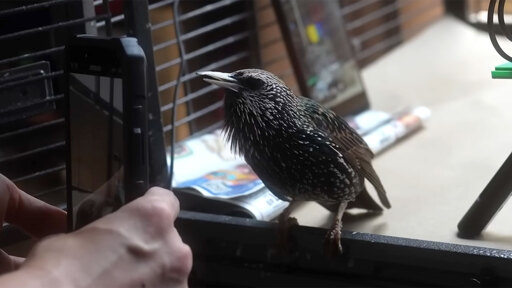A music and science lover has revealed that some birds can store and retrieve digital data. Specifically, he converted a PNG sketch of a bird into an audio waveform, then tried to embed it in the song memory of a young starling, ready for later retrieval as an image. Benn Jordan made a video of this feat, sharing it on YouTube, and according to his calculations, the bird-based data transfer system could be capable of around 2 MB/s data speeds.



These steps are literally the same thing. You’re converting some data into sound for the bird to hear.
Edit: Actually, most physical modulation schemes use sinusoids anyways. So that’s exactly the same as playing a spectrum.
Yes, the near-identical sentences (only drawing a distinction between the processes where one exists) would indicate that. The “heard by the bird” and “reproduced by the bird” steps were also the same. But this is necessary context to make clear the digital data (“bit-stream”) that is being modulated into the signal.
It is far from “exactly the same”. The similarity is only in that both go through the same analogue channel. The entire point is that the modulated signal can be reconstructed exactly, while the spectrogram cannot.
The article title says they converted a PNG and the bird was able to “recall the file”, and yet it produced an indisputably different file. That it looks vaguely the same to the cursory human observer does not make it the same file.
But this isn’t true. Just because a signal is modulated doesn’t mean it can’t be distorted.
A spectrogram is just showing that arbitrary data can be sent though this channel. It’s literally a form of modulation.
I suppose you have caught me out slightly lacking in precision or pedantry. A digital to analogue modulation scheme is able to exactly reconstruct the original digital signal within the design tolerances for noise and distortion. Yes, eventually a signal may degrade or be corrupted, but prior to that point the reproduction is literally and exactly perfect. That exactitude is just about the definition of a digital system. This bird system is incapable of reproducing the input image of the bird exactly. It is not a digital communication system, unless you consider the “PNG” of the bird to have not been the message being carried.
I thought we were being pedantic here?
Modulation schemes are characterized via a probabilistic tolerance, so even when you are within the tolerances, you can get an incorrect value at some expected rate. Note that you can even define a modulation scheme with a high error rate and be ok with that.
That’s why I take issue with the concept of an exactly perfect reproduction. Usually there are layers above the digital modulation to handle these possibility to decrease the error rates even lower.
And no, I don’t consider the PNG to be the data carried. I think the way the author does the bandwidth calculations is incorrect.
No, I have been trying to actually be helpful and informative for people trying to understand this article and video, given that referring to what was done here as a digital system is functionally meaningless and misleading. I am pretty sure the pedantry started with you talking about CPUs being electronic.
But at this point I believe your use of language in this discussion to be so absurdly reductive that I do not think this conversation is salvageable. What you appear to take issue with seems to keep changing and refining until the argument appears to be that any system that communicates information is apparently a digital communications system, so long as you can imagine an arbitrary scheme to interpret at least one bit of information from the signal, regardless of whether that was the message intended to be communicated. It would appear we have ended up with a “digital” storage system wherein a human observes the signal and decides one bit of whether or not it looks like a bird. Though I suppose “bird” was the only symbol in the protocol, so it may actually be a zero-bit system.
If the scheme successfully communicates zero bits of information, you might as well stop bothering to listen for the signal, and miss nothing of value. In fact I should probably do exactly that with this thread.
This has always been my point since the beginning! There exist very low bandwidth digital communication systems in real life, with less than one bit per second. The bandwidth available should be defined where something is digital or not.
Seeing the bird in the spectrogram is quite intentional and sufficient to consider this a communications system.
It seems if instead of a bird picture, a random set of bits were encoded and then detected In the spectrogram, you’d consider this more of a digital system since instead of a human doing the check you use an algorithm?